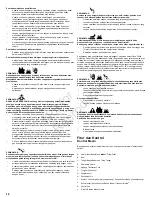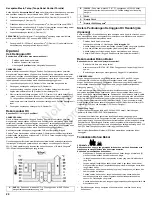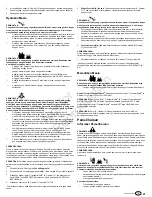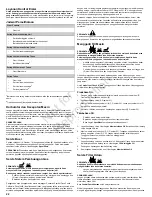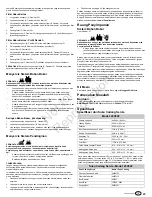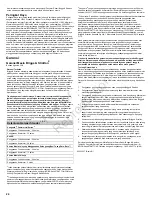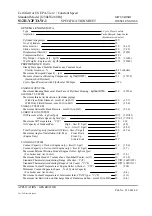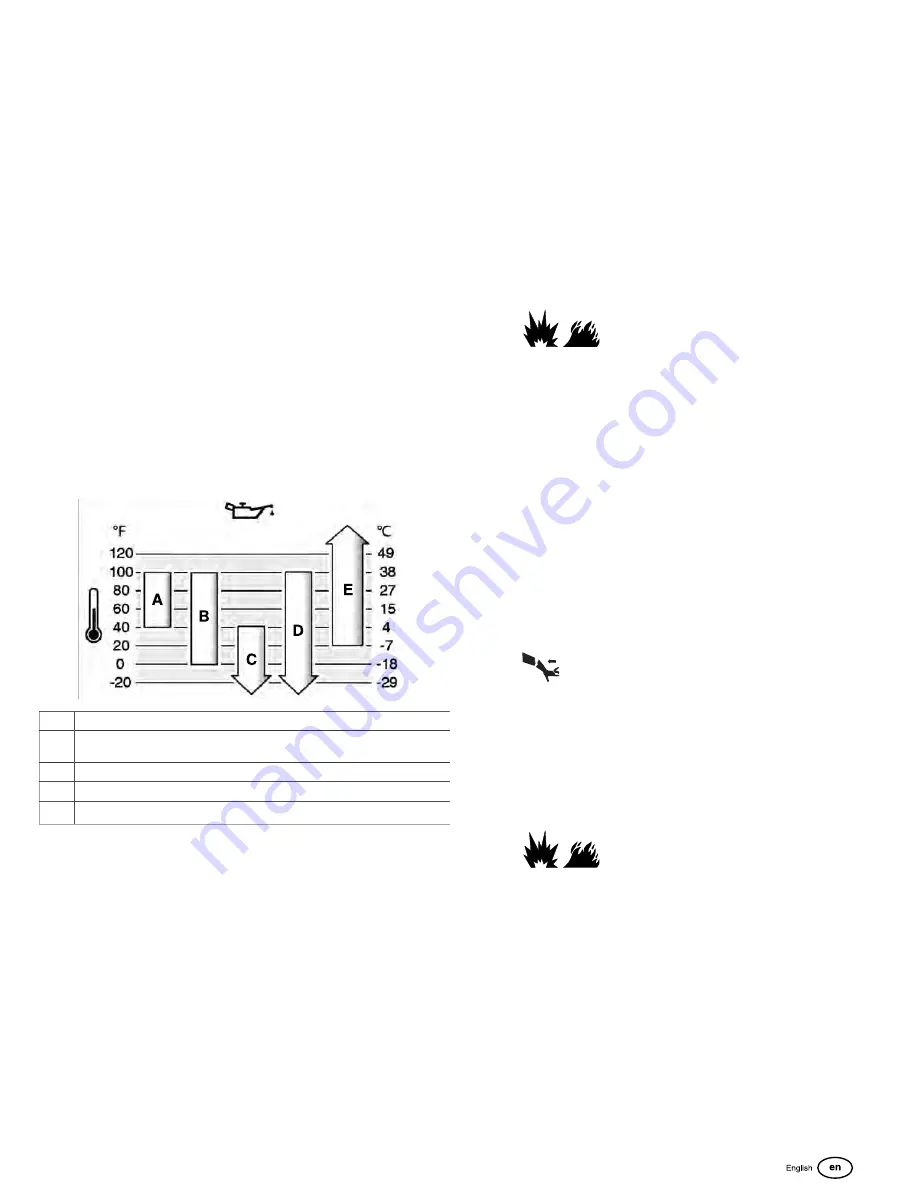
NOTICE
This engine was shipped from Briggs & Stratton without oil. Equipment manufacturers or
dealers could have added oil to the engine. Before you start the engine for the first time,
make sure that the oil is at the correct level. Add oil as specified by the instructions in
this manual. If you start the engine without oil, damage will occur and the engine will not
be repaired under warranty.
1. Remove the dipstick (A, Figure 14) and clean with a cloth
2. Install and tighten the dipstick (A, Figure 14).
3. Remove the dipstick and check the oil level. Make sure that the oil level is at the top
of the full indicator (B, Figure 14) on the dipstick.
4. The engine has two oil fills (C, G, Figure 15). If the oil level is low, slowly add oil into
the engine oil fills (C, G). Do not add too much oil. After you add oil, wait one minute
and check the oil level again. Make sure that the oil level is correct.
5. Install and tighten the dipstick (A, Figure 14).
Oil Recommendations
Oil Capacity
: See the
Specifications
section.
NOTICE
This engine was shipped from Briggs & Stratton without oil. Equipment manufacturers or
dealers could have added oil to the engine. Before you start the engine for the first time,
make sure that the oil is at the correct level. Add oil as specified by the instructions in
this manual. If you start the engine without oil, damage will occur and the engine will not
be repaired under warranty.
We recommend the use of Briggs & Stratton
®
Warranty Certified oils for best
performance. Other high-quality detergent oils are permitted if classified for service SF,
SG, SH, SJ or higher. Do not use special additives.
Use the chart to select the best viscosity for the outdoor temperature range expected.
Engines on most outdoor power equipment operate well with 5W-30 Synthetic oil. For
equipment operated in hot temperatures, Vanguard
®
15W-50 Synthetic oil gives the best
protection.
A
SAE 30 -
Below 40 °F (4 °C) the use of SAE 30 will result in hard starting.
B
10W-30 -
Above 80 °F (27 °C) the use of 10W-30 may cause increased oil
consumption. Check the oil level frequently.
C
5W-30
D
Synthetic 5W-30
E
Vanguard
®
Synthetic 15W-50
Low Oil Protection System (if installed)
A low oil sensor is installed on some engines. If the oil is low, the sensor will show a
warning light or stop the engine. Stop the engine and do the steps that follow before you
start the engine.
•
Make sure that the engine is level.
•
Do an oil check. Refer to the
Check Oil Level
section.
•
If the oil level is low, add the correct amount of oil. Start the engine and make
sure that the warning light (if installed) does not come on.
•
If the oil level is not low, do not start the engine. Contact a Briggs & Stratton
Authorized Service Dealer to correct the oil problem.
Fuel Recommendations
Fuel must meet these requirements:
•
Clean, fresh, unleaded gasoline.
•
A minimum of 87 octane/87 AKI (91 RON). High altitude use, see below.
•
Gasoline with up to 10% ethanol (gasohol) is permitted.
NOTICE
Do not use unapproved gasoline, such as E15 and E85. Do not mix oil in gasoline or
change the engine to operate on alternate fuels. Use of unapproved fuels could result in
damage to engine components, which will not be repaired under the warranty.
To protect the fuel system from gum formation, and corrosion, mix an alcohol-free fuel
stabilizer and ethanol treatment into the fuel. Refer to the
Storage
section. All fuel is not
the same. If start or performance problems occur, change fuel providers or brands. This
engine is certified to operate on gasoline. The emissions control system for carbureted
engines is EM (Engine Modifications). The emissions control systems for engines with
electronic fuel injection are ECM (Engine Control Module), MPI (Multi Port Injection), and
if equipped an O2S (Oxygen Sensor).
High Altitude
At altitudes over 5,000 feet (1524 meters), a minimum 85 octane/85 AKI (89 RON)
gasoline is permitted.
For carbureted engines, high altitude adjustment is required to maintain performance.
Operation without this adjustment will cause decreased performance, increased fuel
consumption, and increased emissions. Contact a Briggs & Stratton Authorized Service
Dealer for high altitude adjustment information. Operation of the engine at altitudes
below 2,500 feet (762 meters) with the high altitude adjustment is not recommended.
For Electronic Fuel Injection (EFI) engines, no high altitude adjustment is necessary.
Add Fuel
WARNING
Fuel and its vapors are flammable and explosive. Fire or explosion could result in
burns or death.
When you add fuel
•
Stop the engine. Before you remove the fuel cap, wait a minimum of two (2)
minutes to make sure that the engine is cool.
•
Fill the fuel tank outdoors or in an area that has good airflow.
•
Do not put too much fuel in the tank. For expansion of the fuel, do not fill above
the bottom of the fuel tank neck.
•
Keep fuel away from sparks, open flames, pilot lights, heat, and other ignition
sources.
•
Frequently examine the fuel lines, fuel tank, fuel cap, and connections for cracks
or leaks. Replace damaged parts.
•
If fuel spills, wait until it dries before you start the engine.
1. Clean the fuel cap area of dirt and debris. Remove the fuel cap.
2. Fill the fuel tank (A, Figure 16) with fuel. Because fuel will expand, do not fill above
the bottom of the fuel tank neck (B).
3. Install the fuel cap.
Start the Engine
WARNING
Fast retraction of the starter cord (kickback) will pull your hand and arm to the
engine faster than you can let go. Broken bones, fractures, bruises or sprains
could result.
•
To prevent kickback when you start the engine, pull the starter cord slowly until
resistance is felt and then pull quickly.
•
Before you start the engine, disconnect or remove all external equipment and
engine loads.
•
Make sure that direct-coupled equipment components, such as, but not limited
to, blades, impellers, pulleys, and sprockets, are correctly attached.
WARNING
Fuel and its vapors are flammable and explosive. Fire or explosion could result in
burns or death.
When you start the engine
•
Make sure that the spark plug, muffler, fuel cap and air cleaner (if equipped) are
correctly installed.
•
Do not crank the engine with the spark plug removed.
•
If the engine is flooded, set the choke (if equipped) to the OPEN or RUN
position. Move the throttle (if equipped) to the FAST position and crank until the
engine starts.
•
If there is natural or LP gas leakage in the area, do not start the engine.
•
Because vapors are flammable, do not use pressurized starter fluids.
9
Not for
Reproduction
Summary of Contents for 25V000
Page 2: ...1 2 3 4 5 6 2 N o t f o r R e p r o d u c t i o n...
Page 3: ...7 8 9 10 11 12 13 3 N o t f o r R e p r o d u c t i o n...
Page 4: ...14 15 16 17 18 19 20 21 22 4 N o t f o r R e p r o d u c t i o n...
Page 5: ...23 24 25 26 27 5 N o t f o r R e p r o d u c t i o n...
Page 73: ...N o t f o r R e p r o d u c t i o n...
Page 74: ...N o t f o r R e p r o d u c t i o n...


















